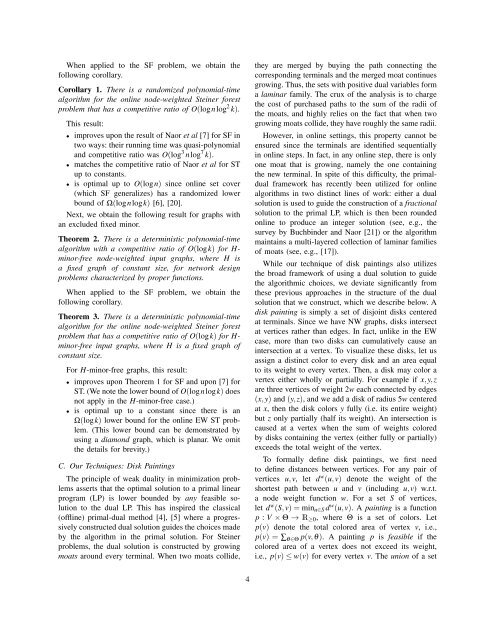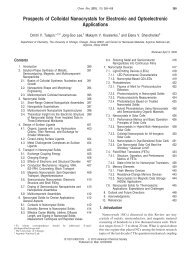Online Node-weighted Steiner Forest and ... - Duke University
Online Node-weighted Steiner Forest and ... - Duke University
Online Node-weighted Steiner Forest and ... - Duke University
Create successful ePaper yourself
Turn your PDF publications into a flip-book with our unique Google optimized e-Paper software.
When applied to the SF problem, we obtain the<br />
following corollary.<br />
Corollary 1. There is a r<strong>and</strong>omized polynomial-time<br />
algorithm for the online node-<strong>weighted</strong> <strong>Steiner</strong> forest<br />
problem that has a competitive ratio of O(lognlog 2 k).<br />
This result:<br />
• improves upon the result of Naor et al [7] for SF in<br />
two ways: their running time was quasi-polynomial<br />
<strong>and</strong> competitive ratio was O(log 3 nlog 7 k).<br />
• matches the competitive ratio of Naor et al for ST<br />
up to constants.<br />
• is optimal up to O(logn) since online set cover<br />
(which SF generalizes) has a r<strong>and</strong>omized lower<br />
bound of Ω(lognlogk) [6], [20].<br />
Next, we obtain the following result for graphs with<br />
an excluded fixed minor.<br />
Theorem 2. There is a deterministic polynomial-time<br />
algorithm with a competitive ratio of O(logk) for H-<br />
minor-free node-<strong>weighted</strong> input graphs, where H is<br />
a fixed graph of constant size, for network design<br />
problems characterized by proper functions.<br />
When applied to the SF problem, we obtain the<br />
following corollary.<br />
Theorem 3. There is a deterministic polynomial-time<br />
algorithm for the online node-<strong>weighted</strong> <strong>Steiner</strong> forest<br />
problem that has a competitive ratio of O(logk) for H-<br />
minor-free input graphs, where H is a fixed graph of<br />
constant size.<br />
For H-minor-free graphs, this result:<br />
• improves upon Theorem 1 for SF <strong>and</strong> upon [7] for<br />
ST. (We note the lower bound of O(lognlogk) does<br />
not apply in the H-minor-free case.)<br />
• is optimal up to a constant since there is an<br />
Ω(logk) lower bound for the online EW ST problem.<br />
(This lower bound can be demonstrated by<br />
using a diamond graph, which is planar. We omit<br />
the details for brevity.)<br />
C. Our Techniques: Disk Paintings<br />
The principle of weak duality in minimization problems<br />
asserts that the optimal solution to a primal linear<br />
program (LP) is lower bounded by any feasible solution<br />
to the dual LP. This has inspired the classical<br />
(offline) primal-dual method [4], [5] where a progressively<br />
constructed dual solution guides the choices made<br />
by the algorithm in the primal solution. For <strong>Steiner</strong><br />
problems, the dual solution is constructed by growing<br />
moats around every terminal. When two moats collide,<br />
they are merged by buying the path connecting the<br />
corresponding terminals <strong>and</strong> the merged moat continues<br />
growing. Thus, the sets with positive dual variables form<br />
a laminar family. The crux of the analysis is to charge<br />
the cost of purchased paths to the sum of the radii of<br />
the moats, <strong>and</strong> highly relies on the fact that when two<br />
growing moats collide, they have roughly the same radii.<br />
However, in online settings, this property cannot be<br />
ensured since the terminals are identified sequentially<br />
in online steps. In fact, in any online step, there is only<br />
one moat that is growing, namely the one containing<br />
the new terminal. In spite of this difficulty, the primaldual<br />
framework has recently been utilized for online<br />
algorithms in two distinct lines of work: either a dual<br />
solution is used to guide the construction of a fractional<br />
solution to the primal LP, which is then been rounded<br />
online to produce an integer solution (see, e.g., the<br />
survey by Buchbinder <strong>and</strong> Naor [21]) or the algorithm<br />
maintains a multi-layered collection of laminar families<br />
of moats (see, e.g., [17]).<br />
While our technique of disk paintings also utilizes<br />
the broad framework of using a dual solution to guide<br />
the algorithmic choices, we deviate significantly from<br />
these previous approaches in the structure of the dual<br />
solution that we construct, which we describe below. A<br />
disk painting is simply a set of disjoint disks centered<br />
at terminals. Since we have NW graphs, disks intersect<br />
at vertices rather than edges. In fact, unlike in the EW<br />
case, more than two disks can cumulatively cause an<br />
intersection at a vertex. To visualize these disks, let us<br />
assign a distinct color to every disk <strong>and</strong> an area equal<br />
to its weight to every vertex. Then, a disk may color a<br />
vertex either wholly or partially. For example if x,y,z<br />
are three vertices of weight 2w each connected by edges<br />
(x,y) <strong>and</strong> (y,z), <strong>and</strong> we add a disk of radius 5w centered<br />
at x, then the disk colors y fully (i.e. its entire weight)<br />
but z only partially (half its weight). An intersection is<br />
caused at a vertex when the sum of weights colored<br />
by disks containing the vertex (either fully or partially)<br />
exceeds the total weight of the vertex.<br />
To formally define disk paintings, we first need<br />
to define distances between vertices. For any pair of<br />
vertices u,v, let d w (u,v) denote the weight of the<br />
shortest path between u <strong>and</strong> v (including u,v) w.r.t.<br />
a node weight function w. For a set S of vertices,<br />
let d w (S,v) = min u∈S d w (u,v). A painting is a function<br />
p : V × Θ → R ≥0 , where Θ is a set of colors. Let<br />
p(v) denote the total colored area of vertex v, i.e.,<br />
p(v) = ∑ θ∈Θ p(v,θ). A painting p is feasible if the<br />
colored area of a vertex does not exceed its weight,<br />
i.e., p(v) ≤ w(v) for every vertex v. The union of a set<br />
4
















